The Untold Secrets Of Vaitheeswaran Temple You Must Know
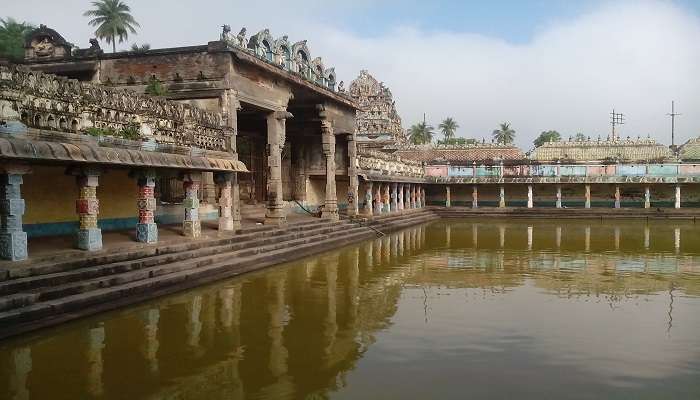
The Vaitheeswaran Temple, a spiritual paradise renowned for its heavenly ties, is a stunning representation of Tamil Nadu’s rich cultural legacy. The name of this Hindu temple, which honours Lord Shiva, conjures images of healing and optimism. Apart from its religious importance, the temple is a marvel of architecture. This living space displays the extraordinary talent and craftsmanship of the skilled artisans in the area. The detailed carvings that grace every square inch of the temple’s exterior portray heavenly creatures, images from Hindu mythology, and exquisite floral designs that astound visitors.
Vaitheeswaran Temple: An Overview
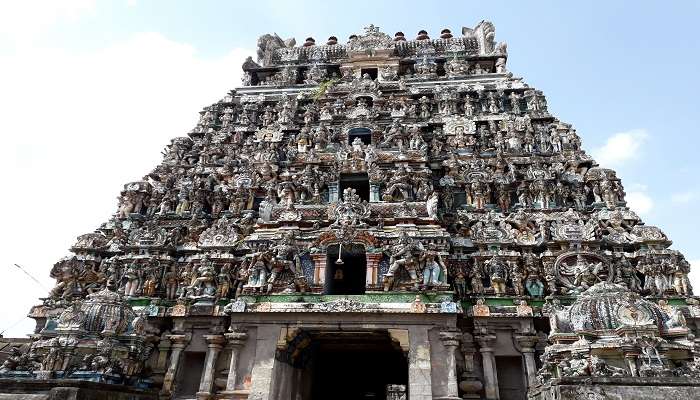
The Vaitheeswaran Temple or Vaitheeswaran Koil is devoted to Lord Shiva as Vaidyanathar, or Vaitheeswaran, which means ‘God of Healing’. The temple is located in Tamil Nadu and is well known for its ability to cure illnesses. Devotees believe that prayers to Vaitheeswaran might result in healing, and the sacred waters of Siddhamirtham temple pond are considered therapeutic.
This Shiva temple is one of the nine Navagraha temples connected to the nine planets. Vaitheeswaran Koil is connected explicitly to Mars (Angaraka). The temple’s significance in Tamil culture is cemented in the Tevaram hymns of saint poets from the 7th century.
Must Read: Temples In Karnataka
Vaitheeswaran Temple History
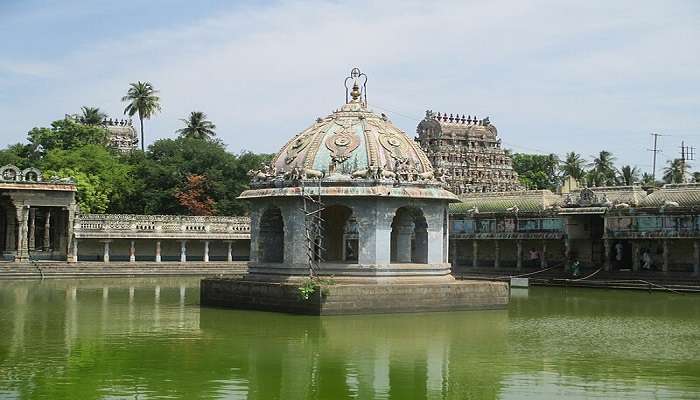
So, what is it about the Vaitheeswaran Temple history that makes it so exciting and mysterious? The Vaitheeswaran Koil, or Pullirukuvelur, is a Hindu temple dedicated to Lord Shiva. Here, Shiva is worshipped as Vaidyanathar r Vaitheeswaran, literally translating to the ‘God of Healing;, making it a beacon of hope for those seeking recovery. Legend has it that during the Ramayana period, Lord Rama, Lakshmana, and the Saptarishi (Seven Sages) sought the deity’s blessings at this sacred site. The temple’s name itself reflects its purpose: “Vaitheeswaran” combines the Tamil words for “doctor” (vaidya) and “God” (Ishvara). This temple is among the nine Navagraha temples linked with Mars, also known as Angaraka.
Vaitheeswaran Koil is renowned for Naadi astrology, which is practised using ancient palm-leaf manuscripts. The temple’s Siddhamirtham tank contains holy waters believed to cure ailments. Over the centuries, rulers like Vikrama Chola, Vira Rajendra Pandya, and Achuthappa Nayak have contributed to its architectural splendour. The temple’s inscriptions date back to Kulothunga Chola I (1070-1120 CE).
Significance Of Vaitheeswaran Temple
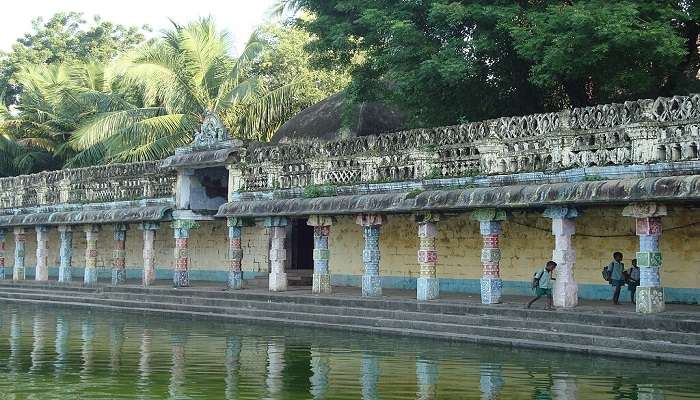
The Vaitheeswaran Temple, also known as the Angarakan Temple, holds significance for several reasons:
Lord of Healing
The temple is dedicated to Lord Shiva, worshipped here as Vaidyanathar or Vaitheeswaran, meaning “Lord of Medicine” or “Doctor” in Tamil. Devotees believe that prayers to Vaitheeswaran can cure diseases and bring mental peace. His consort, Thaiyalnaayaki or Valambigai, is depicted carrying the pot of Sanjeevi Thailam, the medicinal oil for all illnesses.
Navagraha Temple
Vaitheeswaran Koil is one of the nine Navagraha temples associated with the nine planets in Tamil Nadu. This temple is associated explicitly with Mars, known as Angaraka or Chevvai in Tamil. Legend says that Lord Shiva cured Lord Mars for leprosy here.
Ancient History
Though the exact origins are unknown, historical records suggest the temple was built by the Chola kings around the 11th century. Legends associated with the Ramayana add to the temple’s antiquity. It is believed that Lord Rama visited the temple seeking a remedy for a curse-induced illness.
Holy Tank
The temple tank, Siddhamirtham, is believed to possess holy waters with curative properties. Devotees take a dip in the tank as part of the pilgrimage.
Suggested Read: Temples in Triolet
Design And Architecture

The Vaitheeswaran Temple has a grand design and architectural style that reflects Dravidian temple architecture. Its structure is as follows:
Large Scale and Expansive Precincts
The temple complex covers 10.7 acres, signifying its importance and grandeur. It features multiple enclosures or precincts, each with its significance, namely:
- Central Sanctuary (Garbhagriha): The innermost sanctum where the main deity resides. In the Vaitheeswaran Temple, this would be the abode of Lord Shiva.
- Mandapam (Hall): A pillared hall that serves as a place for worshipers to gather, sing hymns, and participate in rituals. There could be multiple mandapams within the complex, each with a specific function.
- Gopuram (Towers): The towering gateways that form the entrance to the temple complex. These ornately decorated structures serve as monumental landmarks and symbolic thresholds between the earthly realm and the divine abode.
- Prakara (Outer enclosures): Concentric corridors that define the temple’s boundaries and provide circumambulation paths for devotees.
- Shrines to other deities (Sub-shrines): Temples in South India often house shrines dedicated to various deities associated with the main deity. These could be separate structures within the complex or integrated into the main building.
Towering Gopurams (Gateway Towers)
A prominent feature is the Rajagopurams, the towering gateway towers that mark the temple entrances. Descriptions mention at least 4 Rajagopurams, with one possibly having 5 tiers. These ornately decorated towers are a characteristic element of South Indian temples.
Symbolic Elements and Design Aspects
The western gopuram is positioned to allow sunlight to fall on the Shivalingam for specific days each year, possibly signifying a celestial connection. The temple also comprises the Sthala Vriksha (temple tree) a margosa tree (Azadirachta indica). It is known for its medicinal properties, reinforcing the temple’s association with healing.
Vaitheeswaran Temple: Deities And Shrines
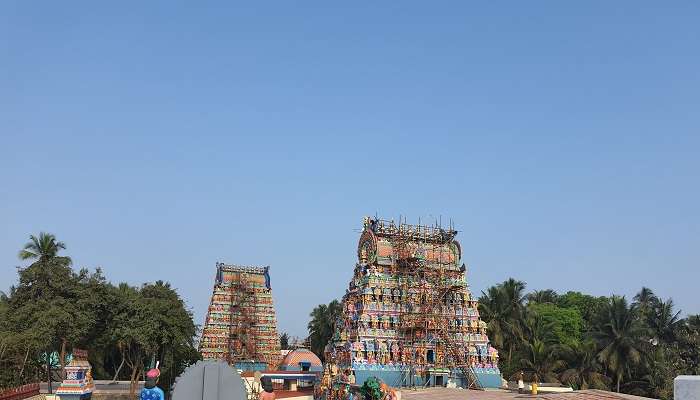
The temple houses various shrines dedicated to different deities. Each shrine holds unique significance, attracting devotees seeking blessings for health, well-being, and prosperity. They are:
Lord Vaidyanathar (Vaitheeswaran)
The central deity of the temple, Lord Vaidyanathar, is revered as the God of healing. Devotees seek his blessings for physical and mental well-being. The lingam representing Lord Shiva is enshrined here, and rituals are performed with utmost devotion.
Goddess Thaiyal Nayaki
Adjacent to Lord Vaidyanathar’s shrine, the temple houses the sanctum of Goddess Thaiyal Nayaki. She is the divine consort of Lord Vaidyanathar and is believed to bestow grace and protection upon devotees.
Subramanya Shrine
A separate shrine is dedicated to Lord Subramanya (also known as Muthukumara Swamy) within the temple premises. Devotees offer prayers to seek blessings for courage, wisdom, and victory over obstacles.
Nine Navagraha Temples
Vaitheeswaran Koil is one of the Navagraha temples, specifically associated with the planet Mars (Angaraka). Devotees visit this temple to mitigate the adverse effects of Mars in their astrological charts.
Suggested Read: Wat Pa Maha Chedi Kaew Temple
How To Reach
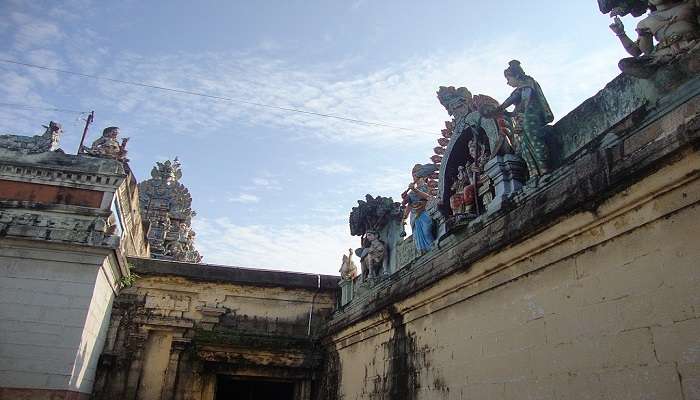
To reach the Vaitheeswaran Koil temple, you can use any of these methods:
By Road
The Vaitheeswaran Koil Bus Stand is near the temple. You can easily find frequent bus services from major cities in Tamil Nadu to Vaitheeswaran Koil.
By Rail
The closest railway station to the temple is Mayiladuthurai Junction, approximately 27 Km away. You can take a train to Mayiladuthurai and then proceed to the temple by hiring a private taxi or using the local buses
By Air
The nearest airport to Vaitheeswaran Koil is the Tiruchirappalli International Airport, about 170 Km away. Alternatively, you can consider flying to Chennai International Airport, approximately 235 Km from the temple. You can take the bus and cab to reach the temple
Vaitheeswaran Temple Timings

You must have an idea about the Vaitheeswaran Temple timings to ensure you have a great experience. The temple timings are:
| Pooja | Timing |
| Morning Abhishekam | 6:00 am to 12:30 pm |
| Noon Pooja | 12:30 pm to 1:00 pm |
| Evening Abhishekam | 4:30 pm to 8:30 pm |
| Night Pooja | 8:30 pm to 9:00 pm |
Further Read: Temples In Rishikesh
Vaitheeswaran Temple offers a captivating mix of spirituality, history, and architectural beauty. Its ancient origins and the healing powers attributed to the presiding deity make it a must-visit destination for travellers seeking cultural immersion and spiritual rejuvenation. Don’t miss the opportunity to explore this sacred site and experience the profound energy it exudes. So, why wait? Book your trip to Karnataka and start on a journey that will leave you spellbound by the enduring beauty and cultural richness of this charming destination.
For our editorial codes of conduct and copyright disclaimer, please click here.
Cover Image Source: Shutterstock
Frequently Asked Questions About Vaitheeswaran Temple
What time is the Darshan at Vaitheeswaran Temple?
The temple offers darshan (viewing of the deity) from 6:00 am to 09:00 pm.
What is the other name of Vaitheeswaran?
Vaitheeswaran Koil is also known as Pullirukuvelur. The presiding deity, Lord Shiva, is worshipped as Vaidyanathar or Vaitheeswaran, which translates to the “God of healing” in Tamil.
What are the rituals of Vaitheeswaran Koil?
The temple follows various rituals, including daily pujas, abhishekams (ritual baths), and special ceremonies during festivals. Devotees seek blessings for health and healing from Lord Vaitheeswaran.
Which God is Vaitheeswaran?
The primary deity of Vaitheeswaran Koil is Lord Shiva, specifically worshipped as Vaidyanathar or the God of Healing.
What is famous in Vaitheeswaran Koil?
Apart from its spiritual significance, Vaitheeswaran Koil is renowned for its Siddhamirtham tank, believed to contain healing nectar. A dip in its waters is considered beneficial for curing ailments.
People Also Read:
Kataragama In Sri Lanka Dambulla Cave Temple Triyuginarayan Temple

Embrace the essence of surreal places around the world through perfect narratives with a touch of imagination. As a content writer, I weave my ideas and words together to create a vivid picture of alluring destinations. Embark on limitless adventures as you read thrilling travel stories.











